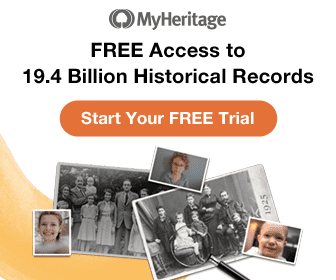We all know someone who claims ties to George Washington or original families who arrived on the Mayflower. Certainly, there are many people who descend from Mayflower ancestors however, lines to George Washington are nonexistent. With that said, family tales may not always line up to what we are told. However, the biggest letdown is when you grow up believing you have Native American ancestry and your DNA results say otherwise. Why does your Ancestry DNA not show your Native American Heritage?
Look to the paper trail
For those who have paper trails in their family trees tying them to Native Ancestors and their DNA still lists zero percent, this is very common. It does not mean you are not descended from those ancestors. To make sense of this let us discuss one of the biggest misleading conceptions.
If we look back at fairly recent census (19 and 20th century) records on Native reservations they generally list the amount of native blood. So, for instance, let us say we have Jean in a 1910 “Indial-Roll” who’s father is half French, from his paternal grandfather, and half Cree from his paternal grandmother. His mother is only Cree, to Jean’s knowledge. Thus, in census records, he would be listed as seventy-five percent Native American.
Well, Jean does not realize this but his paternal mother has very Scottish roots that date back to the early days of the Hudson Bay Company. He assumed his paternal line’s Native ancestry but he was not certain. The same goes for his mother. Her grandfather was born in Ireland.
When our historical records discuss the amount of blood, it is not an exact science and, as humans, we tend to assume things that are not always scientific. Now, Jean cannot be blamed because he was long dead before Ancestry.com and, furthermore, because the world was not up to speed on the scientific front of genetics. The other reason you may not see Native Ancestry in your DNA results is, ultimately, recombination.
Recombination
The general assumption that people usually have, and that Jean also had above, is that we inherit exactly fifty percent of our parents DNA. Though this is not wrong, we have to remember that the science is not exact and we can inherit forty-five percent from one parent and fifty-five from the other. This means that if Jean inherited fifty five percent from his father’s DNA then forty five percent of his father’s DNA does not get passed along. That is a huge chunk! So, if this is the case, Jean’s mother only gave him forty five percent of her DNA which means over half of her DNA was not passed on.
Now, rinse and repeat for every single generation. Parent to child, parent to child, and the DNA begins to get washed out. It is entirely possible to share zero DNA with your 2x great-grandparents. That means a true third cousin might not even show up as a match. It’s unlikely but possible.
When we inherit our parent’s segments, they don’t get to choose which segment they pass along. They take the DNA they inherited from their parents and pass half, maybe less, maybe more, on to you.
With that said, if you had a fourth great grandparent who, according to the paper trail was full blooded Cree, the segments he passed along to your third great grandfather might not have survived the random selection during recombination. Furthermore, he may not have been “full blooded” in the genetic sense.
Let’s continue with the example of Jean –
Jean’s great-great granddaughter was very discouraged when no Native American DNA populated on her ethnicity “estimate” from AncestryDNA. She had to dig more in order to find out what happened. She faced an even more discouraging reality at the lack of records along the paper trail which inhibited her from really understanding this mystery. See my other article on the best DNA test kits for Native American ancestry.
Some Native history
In situations such as these, is it very important to realize that, though Europeans have only been in North America since the 1500’s (Spanish settlements in modern day Florida), they have had upwards of three hundred years to “mingle” with other ethnic groups that are a part of our Native American populations. “Mingling” is a normal occurrence that depletes a “pure” line of Ancestry. I say “pure” because there really is no such thing. We could tell, genetically, if someone was likely to be descended from hundreds of years of only Native American populations but, we must remember, thousands of years ago they were considered Asian coming across Beringia (the submerged continent beneath the Bering Sea). Before that, they were African.
Though our Native ancestors may have identified as Native, that does not mean they did not have European ancestry.
Jean’s discouraged descendant grew up in Montana. Her family has been there for as long as they can remember. Though she was upset at the lack of Native American DNA that populated within her ethnicity “estimate”, she understood that her family roots were in an area frequented by European fur traders in the early days of Western exploration. Certainly, Jean had stronger European ties than he was unaware of.
Ethnicity estimates
One of the last things to take into consideration (and you may have noticed my quoting it throughout this article) is the word, “estimate”. AncestryDNA bases their user’s ethnicity “estimates” off of their base samples. The base samples for their Native American ancestry are constantly undergoing updating as sciences improve. In fact, they are updating all of their data across the board. Thus, if you have signed in, got upset at there being no Native American DNA and not logged back in, maybe log back in and take a look around. Chances are, there has been an update to your results. DNA technology improves very rapidly and if you happen to have some DNA that truly is from a Native American ancestor, chances are it is bound to populate in your results at some point.
Get a second opinion
Another approach is uploading your DNA to other websites which use different base samples and different algorithms. These sites include MyHeritage, FtDNA, and Gedmatch. Gedmatch has some very in-depth admixture tools that look specifically for “AmerIndian” DNA. Uploading to these sites, you will be able to get a different look at the same data. More often than not, their percentages on their ethnicity estimates vary greatly.
Final thoughts
Recombination is something that people often fail to understand or remember and, the concept of our ancestors identifying themselves as Native when they were not aware of their European ancestry is not something we can fault them for.
Most of the time, it is a hard pill to swallow when your DNA does not match up with your family tree or with the family lore you have heard growing up and that you have always identified with. Feeling in tune with our ancestry and our heritage is something that we all crave. It offers a strong sense of belonging. Just remember some of the things discussed in this article and don’t let the lack of DNA make you feel like you’re not your ancestor’s descendant. Whether you inherit DNA from them or not, you are still a piece of their legacy. Without them there may not have ever been a you.


